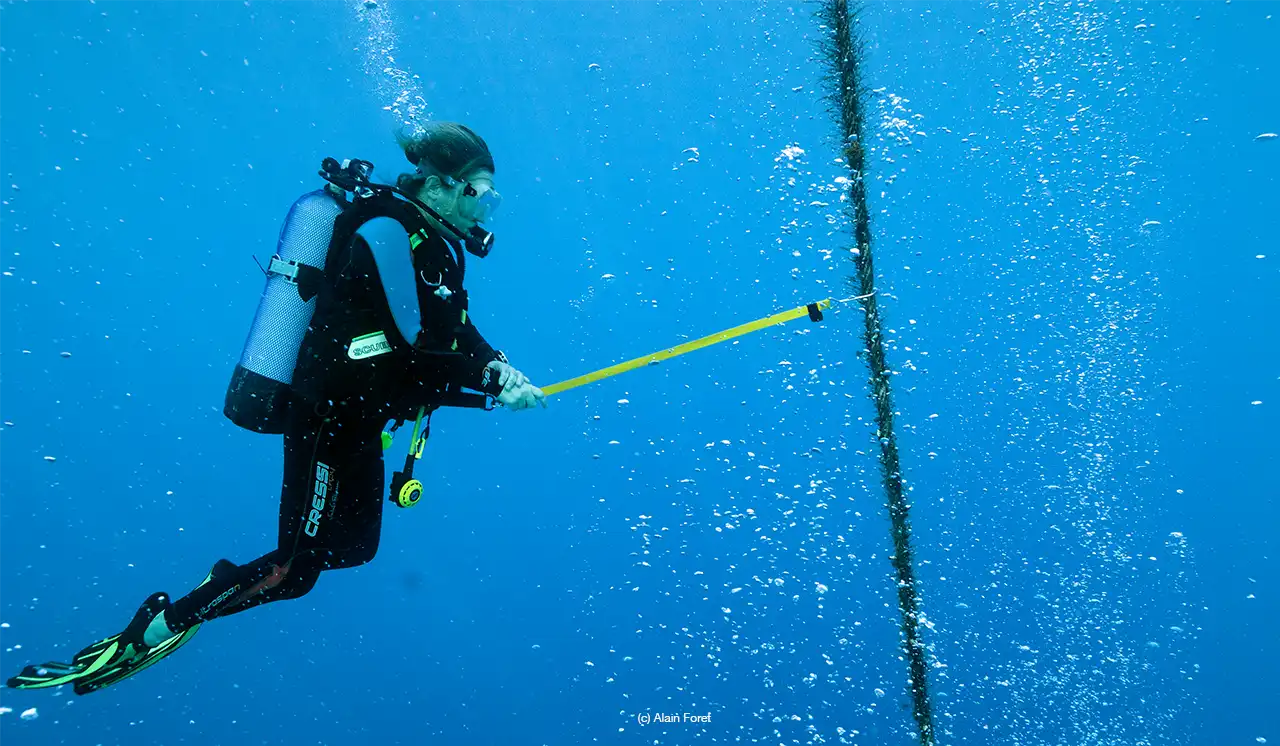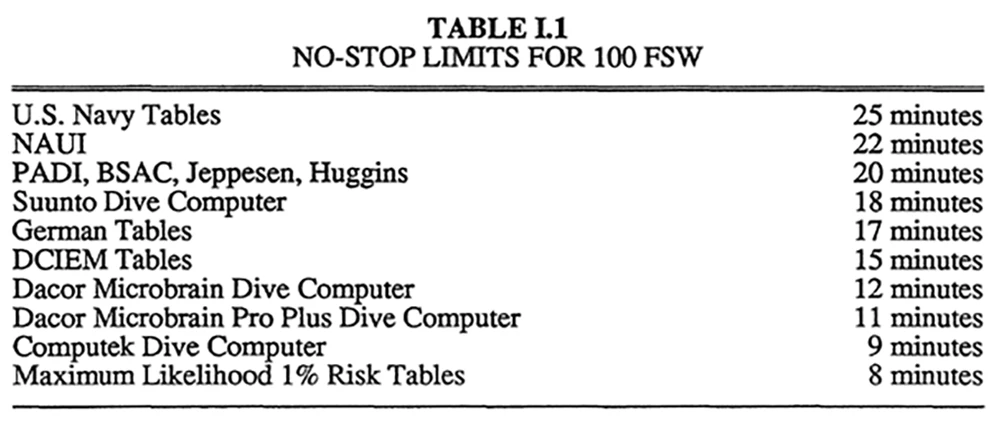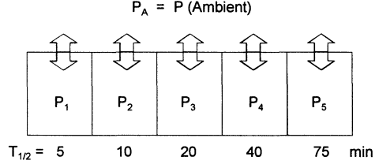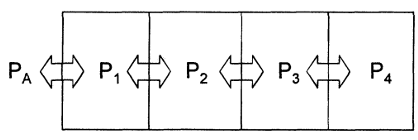DCIEM
Desaturation model
Defense and Civil Institute of Environmental Medicine (Canada)
Ref. 25-034/CMAS/TC - 2 october 2025

1. History
The DCIEM desaturation model is the result of a programme launched in 1962 by D.J. Kidd and R.A. Stubbs, which led to the KS-1971 model (Kidd and Stubbs 1971) and was subsequently improved by Nishi and Lauckner to produce the DCIEM 1983*.
* R.Y. Nishi and G.R. Lauckner, Developement of the DCIEM 1983 decompression model for compressed air diving, DCIEM No. 84-R-44, september 1984.
This publication is freely available on the Canadian government website: https://publications.gc.ca/collections/collection_2025/rddc-drdc/DR52-19-35-1984-eng.pdf
The objective was to develop a desaturation protocol that was safer than the one proposed at the time by the U.S. Navy (U.S. Navy tables) and to overcome certain limitations of the Haldane model, such as repetitive or multiple dives.
Latest publication of the DCIEM tables: 1992.
In this regard, Huggins presents an interesting comparison that highlights an obvious fact: the more the decompression stops increase or the more the no-stop limits are reduced, the lower the risk of DCS.
This makes DCIEM one of the safest models in the world.

Karl E. Huggins, The dynamics of decompression workgroup, The University of Michigan, 1992, p. 7.
2. Main difference with Haldane's model
HALDANE (Us-Navy, Bühlmann, RGBM, VPM...) : set of parallel compartments, with overall consistency ensured by a ‘control compartment’ at each stage (level) of the ascent.
DCIEM: Four compartments in series that flow into each other.
HALDANE

DCIEM

3. Ascent speed
Initially set at 18 m/min, then reduced to 15 m/min +/- 3 m/min in the printed tables.
Reminder: ascent speed is not part of the desaturation model. It is a parameter that can be modified.
For example, Haldane had adopted a speed of around 10 m/min (4 to 10 m/min depending on depth), whereas subsequently Haldanean parameter sets such as those of the U.S. Navy adopted an ascent speed of 18 m/min before returning, in 1993, to 10 m/min (U.S. Navy diving manual, February 1993).
4. Repetitive dives
41. HALDANE
As indicated by Haldane in his 1908 publication, Haldane did not model repetitive dives. Thus, the only procedure that existed between 1908 and 1949 was to add the duration of the first dive to the second dive.
Haldane J.-S. et coll., The Prevention of decompression air Illness, J. Hyg., 1908, pp. 369-370:A diver has often to descend twice or oftener at short intervals. At the beginning of the second descent the more slowly desaturating parts of the body will not have had time to lose their excess of nitrogen, and consequently they will be more highly saturated at the end of the second descent than would otherwise have been the case. This will be clear from a study of Figs. 2 or 3. To meet the increased risk in decompression it is desirable, in calculating the proper stoppages, to add together the two periods of exposure, and adopt thc corresponding rate of decompression shown in the tables.
Following the work of Commander Jean Alinat (GRS, now CEPHISMER, French Navy) in 1948, a first publication was made in 1949 proposing the Repetitive Group (RG) method, which was then adopted worldwide and adapted for integration into dive computers.
Return time for a single dive: in the GPS procedure created by Commander Alinat, according to the compartment considered to control the surface interval (6 times the half-time of the compartment, i.e. 12 hours for Cx:120; 8 hours for Cx:80; 6 hours for Cx:60).
MN90 (Marine nationale tables - French Navy): 12 hours.
42. DCIEM
The dives are directly managed by the ‘serial’ modelling of the four compartments. "The repetitive diving procedures developed for the DCIEM 1983 model (...) take into account the depths and bottom times of the first and second dives, as well as the surface interval between dives. ‘The DCIEM 1983 decompression model has been evaluated for certain dive profiles, including combinations of repetitive dives, using the Doppler ultrasonic bubble detector.’
Return time to a single dive: 18 hours (DCIEM Manual).
References:
- Haldane J.-S. et coll., The Prevention of decompression air Illness, J. Hyg., 1908, pp. 369-370.
- Note N°172/CEPHISMER/NP du 3 décembre 2024. French Navy.
- U. S. Navy Diving Manual, 1916, chapitre X, p. 84.
- Tailliez P. et coll., La plongée en scaphandre, Éditions Elzévir, 1949, p. 103. English version, The Complete Manual of Free Diving, Arthaud & Putnam's Sons, New-York, 1957, pp. 115-120.
- PV « Essais et recherches » n°41, GRS, du 12 mai 1948. French Navy.
- Note 177 GRS du 12 mai 1948. French Navy.
- PV « Essais et recherches » n° 47 GRS. French Navy.
- Note n°84 GRS du 16 mars 1949. French Navy.
- Note n°218 GERS du 9 août 1952. French Navy.
- Lang and Vann in Proceedings of repetitive Diving Workshop, American Academy of Underwater Sciences, March 18-19, 1991, Duke University Medical Center, Durham, North Carolina, USA, p. 123.
- Development and validation of no-stop decompression procedures for recreational diving, The DSAT Recreational Dive Planner, 1994, p. 22.
- Foret A., Plongée Plaisir 4, 12e édition, 2025, pp. 269-276.
- Foret A., capitaine de corvette de réserve (CEPHISMER, Marine nationale), Désaturation : le commandant Alinat et les plongées successives, Plongez ! n°56, mars-avril 2025.
- Foret A., Ordinateurs de plongée et paramètres haldaniens : comment gérer les successives ?, Worldivers ResearchGate, novembre 2024.
- R.Y. Nishi and G.R. Lauckner, Developement of the DCIEM 1983 decompression model for compressed air diving, DCIEM No. 84-R-44, september 1984, pp. 15 et 19.
- DCIEM Diving Manual 1992 : https://diving-rov-specialists.com/index_htm_files/docs-1-dciem.pdf
5. Why teach the DCIEM model?
Because it is available as an option on certain dive computers (e.g. certain models from Shearwater).
There are currently two desaturation models available on the dive computer market:
- The Haldane* model, mainly with the Bühlmann ZH-L 16 C set of parameters (and formerly with the RGBM, U.S. Navy or other sets of parameters).
- The DCIEM model.
There is a third desaturation model, BSAC'88. However, the mathematical formulas and parameters for this model have not been disclosed by its designers.
* Note: RGBM and VPM, sometimes presented as non-Haldanean, use Bühlmann's set of parameters. They are therefore Haldanean (parallel compartments). Source : RGBM in depth, Bruce Wienke, p. 34 and source code VPM in fortran: "This program uses the sixteen (16) half-time compartments of the Buhlmann ZH-L16 model."
6. Why has the DCIEM model not been implemented in all dive computers?
Because it is not royalty-free, a commercial licence is required in order to use it.
7. Questions and Answers
7.1 What is the difference between a desaturation model and a set of parameters?
For example, Haldane's model uses:
- An equation for determining the saturation level of compartments (Haldane equation or its Schreiner variant);
- An equation to define the conditions for the ascent (M-Values, possibly reduced by GF).
The main parameters (variables) are half-lives with their supersaturation tolerance thresholds (M-Values).
Secondary parameters include ascent speed, atmospheric pressure, water density, etc.
Examples of Haldanian sets of parameters:
- U. S Navy;
- Marine nationale (French Navy) 1990 or 2023;
- Comex;
- Hahn;
- Bühlmann ZH-L 16 C.
The three desaturation models currently in use:
- Haldane with Bühlmann ZH-L 16 C set of parameters (in almost all dive computers);
- DCIEM, optional on certain Shearwater computers;
- BSAC'88, in the United Kingdom (algorithm not disclosed to the public).
7.2 What does the DCIEM model offer?
The DCIEM model was developed in Canada between the 1960s and 1980s. The DCIEM 83 version is the most advanced.
- The DCIEM's approach was to develop a safer model than that proposed by the US Navy. For example, for a dive to 30 m, the no-stop limit is 25 minutes for the US Navy, compared to 15 minutes for the DCIEM tables.
- Furthermore, with its serial compartments, the DCIEM natively manages repetitive dives. This is not the case with Haldane, where an additional algorithm must be added to ensure the safety of repetitive dives.
7.3 What is THE main difference between Haldane's model and the DCIEM model?
Haldane: parallel compartments, consistency between compartments ensured by the controlling compartment logic (its ascent conditions apply to all others).
DCIEM: serial compartments that flow into each other, automatically ensuring the tracking of multiple dives over 18 hours.
7.4 How long must a diver remain on the surface before returning to a single dive? Answer for both the Haldane model and the DCIEM model.
Haldane: according to the surface control compartment, not modelled, additional procedure created by Commander Alinat between 1948 and 1952. If 120 min, 120 x 6 = 12 hours. If 60 min, 60 x 6 = 6 hours.
DCIEM: 18 hours, data set by the model.
7.5 Is ascent rate always linked to the desaturation model?
No.
The U.S. Navy tables were changed from 18 m/min to 10 m/min by simple recalculation, without modifying the set of parameters (U.S. Navy, February 1993).
The M.N.90 tables were recalculated in 2023 to change from 17 m/min to 12 m/min (French Navy tables 2023).
The DCIEM tables, with an original speed of 18 m/min, were published in a submersible version with a speed of 15 m/min +/- 3 m/min, i.e. from 12 to 18 m/min.
